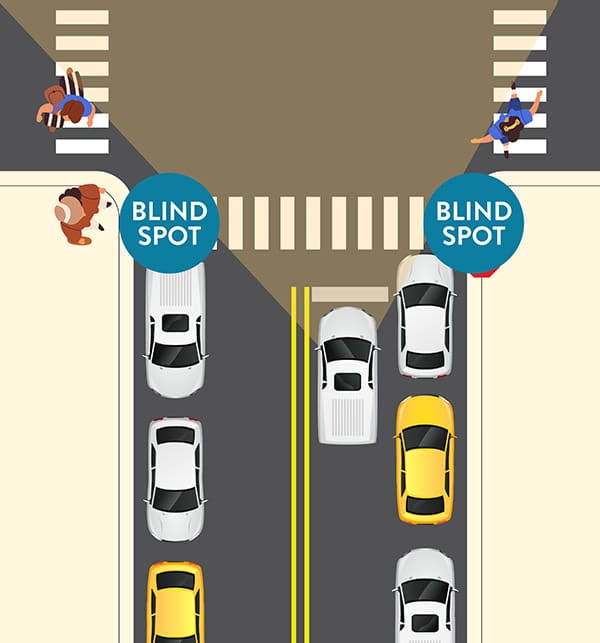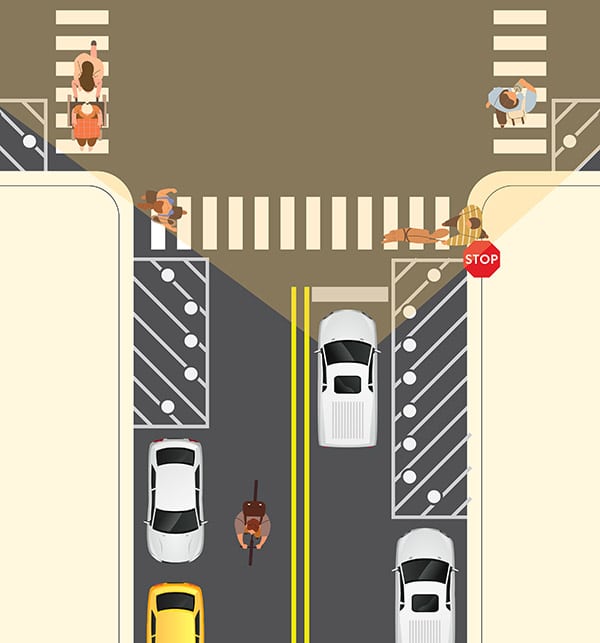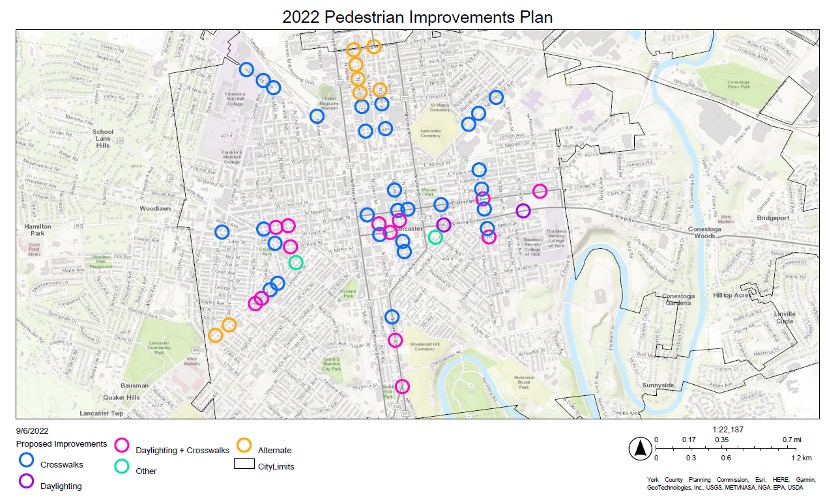What can we help you find?
Vision Zero: What is Intersection Daylighting?
You may have recently noticed some changes to streets in your neighborhood. This is known as intersection daylighting, an urban design strategy that enhances safety and visibility at intersections and crosswalks. Let’s explore the importance and impact of this technique on creating safer streets for all.
What is “Intersection Daylighting?”
Intersection daylighting is a safety improvement that restricts parking near intersections. This makes it easier for road users to see and respond to each other. Daylighting can be accomplished quickly and affordably by placing flexible, vertical posts at intersections and adjacent to crosswalks.
What is the purpose of this treatment?
Intersection daylighting improves safety at intersections. According to the Federal Highway Administration, restricting parking near intersections can reduce pedestrian crashes by 30% (Source, PDF). Removing parked cars reduces blind spots. This gives drivers, pedestrians, and cyclists a better view of the intersection, which provides more time to respond to others approaching road users. It can also help to slow turning vehicles so they’re more likely to see and yield to pedestrians in the crosswalk.
Before Daylighting

After Daylighting

Why does the City install this treatment using white flex posts?
White flex post installation is a relatively quick and low-cost process. Posts can be installed and maintained by City staff. Unlike many other safety improvements, flex post installation does not require a lengthy permitting or approval process. Flex posts can also be temporarily removed if necessary due to emergencies, heavy snow, or other conditions.
Can intersection daylighting be accomplished in other ways?
Yes. This treatment can be made permanent by adding infrastructure such as curb extensions (bulb outs) or vegetated curb extensions (planted areas surrounded by curb that capture stormwater runoff and help to prevent flooding.) These projects have many benefits, but also require more time, planning, approvals, funding, and may require traffic and pedestrian diversion during construction.
How did the City select locations to daylight?
The intersection daylighting treatment, along with other low-cost design treatments to improve intersection safety, are recommended in the City’s Vison Zero Plan.
Locations for intersection safety improvements were prioritized based on several factors, including:
- Located along the High Injury Network
- Located near a school
- Top 10 intersections with the most serious and fatal crashes
- Had poor crosswalk condition based on the crosswalk condition inventory
- Was NOT part of a larger, planned street improvement project
Does Daylighting remove parking spaces?
Daylighting does not remove legal parking spaces. It prevents parking in areas where it is illegal to park by state and city law.
Where is it illegal to park near an intersection or crosswalk?
In Pennsylvania, it is illegal to park within 20 feet of a crosswalk at an intersection or within 30 feet of any flashing signal, stop sign, yield sign, or other traffic control device located at the side of a roadway. It is also illegal to park on the sidewalk; in an intersection; on a crosswalk; within 15 feet of a fire hydrant; or on the roadway side of a vehicle already stopped or parked along the edge or curb of the street (double parking). For additional information, please see the PA DMV Driver’s Manual,Pennsylvania Code (Title 75, § 3353), or City of Lancaster Code (§285-15).
Why do the lengths of daylighting areas vary at different intersections on different sides of the street?
The length of daylighting areas is based on illegal parking areas in accordance with state and city law, as well as traffic direction.
For example, on the approach to a stop sign, it is illegal to park within 30 feet of the sign – thus, the daylighting area will be 30 feet from the stop sign on one side of the street. Stop signs may be located at slightly different distances from each intersection, which can lead to minor variations at different locations.
On a two-way street, one side of the street will not have a stop sign (because it is receiving vehicles from other legs of the intersection.) Thus, the daylighting area on that side will only be 20 feet long as measured from the crosswalk.
Where has intersection daylighting been installed in the City of Lancaster (as of 2023)?
Intersection daylighting, as well as other low-cost intersection improvements have been placed at locations around the City, primarily along the High Injury Network as identified in the Vision Zero Plan. Please see the map below (noting that some minor changes were made between the 2022 plan and 2023 installation).

How does the City notify the public about these improvements?
Public notice was not given to immediate neighbors for installation of this infrastructure because it does not require road closure or removal of legal parking spaces, and can be completed in a relatively short period of time. The City is working on additional educational materials about these treatments, and is open to other methods of notification.
Why are some daylighting areas removed in the winter?
Daylighting areas located along designated snow emergency routes are removed in November and December in preparation for the winter. Posts will be replaced in the spring. The City Department of Public Works is responsible for winter street maintenance and snow plowing. The City is required to plow designated snow emergency routes from curb to curb.
